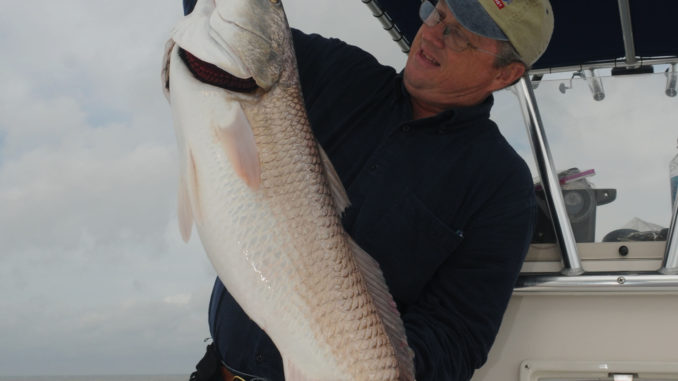
Big fish moving back from winter spots gang up at mouth of southern OBX inlets
Cobia are on the minds of a lot of the fishermen who charter guide Ken Dempsey of Hatteras this month, but he knows that May’s big draw might be a strong, powerful fish that’s moving in from the ocean — it’s just a copper-colored brute, not a brown one.
“I tell the folks who come down to cobia fish this month that they might be a little early, but we’ve always got the big redfish out there,” said Dempsey (252-986-2102). “May is when the big reds school up and get around Hatteras and Ocracoke inlets.”
The big reds move in from the nearshore reefs where they overwinter when the water temperature hits the mid-60s, and they may stay six weeks before moving through the two inlets and across to the western side of Pamlico Sound where they spend the rest of the year.
But that’s a great six weeks for Dempsey and his parties, which might run into schools of big reds — “the big mumbo jumbos,” he calls them — that cover enough area that they literally turn the water a reddish hue.
“The majority of people sight-fish for them,” Dempsey said. “They don’t bust on top, so you’re looking for that red color. If you get a dead, calm day down here, you might see them swirling the water, but days like that are few and far between down here.”
Dempsey said most Hatteras fishermen targeting big reds are fishing heavy casting or spinning gear, flinging bucktails and casting spoons from 1 1/2 to 4 ounces.
“If we get the right wind from the southwest and west, you can find ‘em here when the water temperature gets to about 65 degrees,” he said. “If you had your druthers, you’d want it between 70 and 74, but if you’ve got the temperature steadily coming up, anything about 65 will be just right. If it cools off, they’ll pull back out and wait for conditions to get right before they come back in.”
Dempsey said that the reds will get on both the north and south sides of Hatteras and Ocracoke inlets when they get ready to move through, often setting up shop on the big sandbars that run parallel to the surf.
“They don’t all come in at the same time; you can catch ‘em here all the way into June. Most of them will be here until the third week of June.
“Last year, they moved through Hatteras Inlet and stayed on the first big reef behind the inlet for a while. Every time we had a wind out of the north, you could go back there and catch ‘em without having to go in the ocean.”
Dempsey said that dirty water can slow down sight-fishing for big reds, but there’s an alternative.
“You can soak bait right on top of the sandbar, but you can also catch ‘em trolling,” he said. “I’ll troll a white/red Stretch 30 right down the back of the bar. When one hits, the whole school will often come up behind it, and then everybody rushes to the stern and slings bucktails at ‘em.”


Be the first to comment